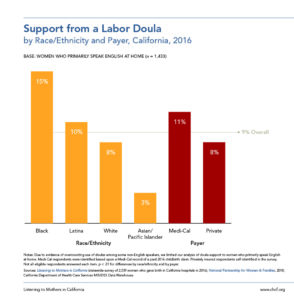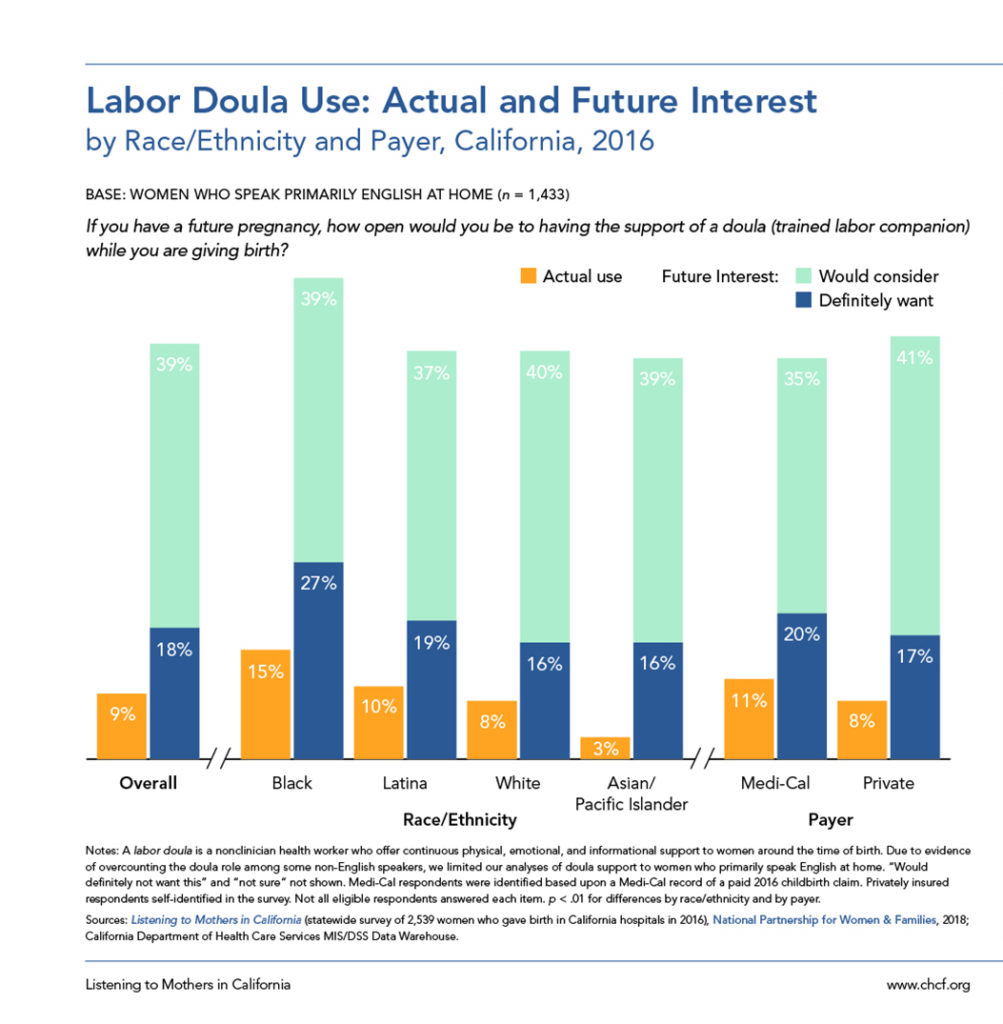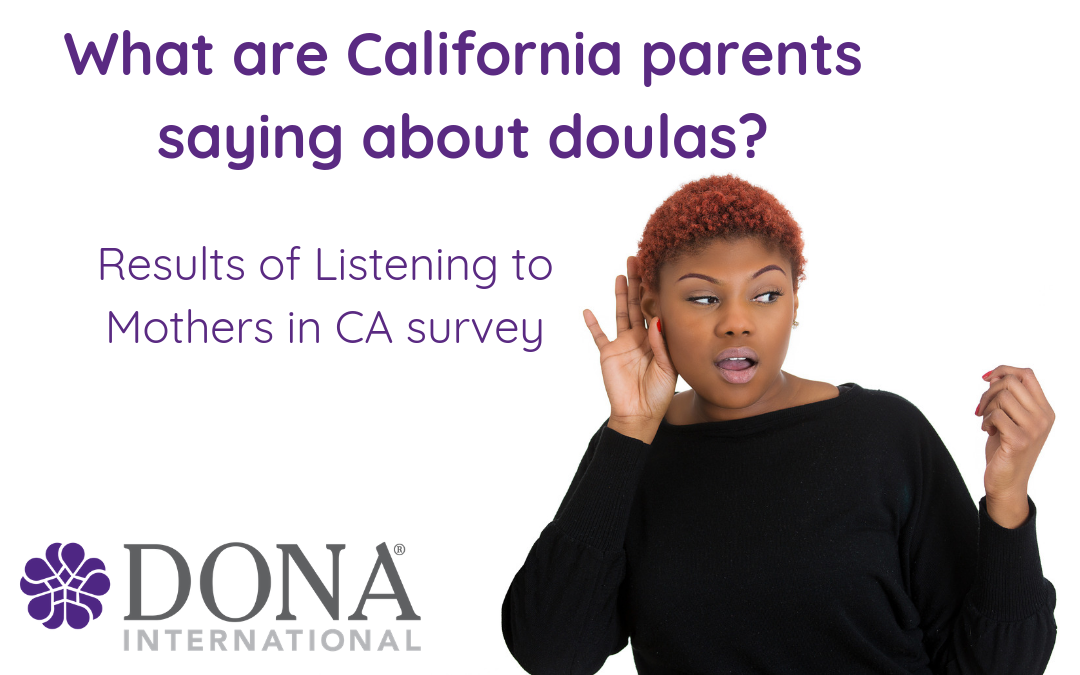By Sharon Muza, BS, CD(DONA), BDT(DONA), LCCE, FACCE, LCE
2018 Listening to Mothers in California survey results were released earlier this month and the information shared is immensely interesting. This is the first Listening to Mothers survey done on a state level and examines the desires, experiences, and outcomes of families who gave birth in California in 2016. I covered the research study in depth here and interviewed the lead researcher here, but today on the DONA Doula Chronicles blog, I wanted to take a deeper dive into what California families had to say about doulas. This information is useful not just for those of doulas serving in California but for doulas everywhere.
What did the survey say about doulas?
15 percent of overall survey respondents indicated that they had a doula attend them during their labor and birth. This is more than twice the number of births reported attended by a doula in the most recent 2013 national Listening to Mothers survey (6%). Investigators wanted to explore why this might have been the case. The conclusion that was reached was that for many Latina families, (California has a large Spanish speaking population) the role of the doula (and the terminology) is not well known. Many families may have been confused about the vocabulary and considered their midwife or L&D nurse having served that role.
The role of the doula was more familiar to younger birthing people and respondents who completed the survey in English. 11% of those who took the survey in English stated they used a doula and 33% of those who took the Spanish version stated that a doula supported them. It is possible that the translation of the doula role or a lack of understanding of the differences between a doula and a health care provider artificially inflated the responses of those who responded to the Spanish language survey. For the purpose of examining the rest of the results, the investigators felt that 9% was a more accurate value and operated on that premise.
According to the published study:
Looking at breakdowns limited to survey respondents who usually speak English at home, 4% reported having doula support prenatally, while giving birth and postpartum; 2% prenatally and while giving birth; <1% while giving birth and at home afterward; and 2% solely while giving birth.
Limiting further breakdowns to survey respondents who usually speak English at home, use of a labor doula ranged from 15% among Black women to 3% among Asian and Pacific Islander women (p < .01) and was 11% among Medi-Cal beneficiaries versus 8% in women with private insurance (p < .01).
 Plans for future pregnancies
Plans for future pregnancies
When examing the results from those who responded to the English version of the survey, 57% percent of survey takers indicated that they would be open to having doula birth support for a future pregnancy. In fact, 18% said that they would definitely want this and 39% said that they would consider this. Please note that this is 4 times greater interest in doula support than those who actually had doulas attend their birth. Doulas in California and elsewhere should consider that there is a greater desire for using the services of doula after the experience of giving birth.
For the survey families who did have a doula at their birth, 84% indicated that they would be open to using a doula in a future birth as well. 50% of people who had a cesarean (planned and unplanned) expressed interest in a doula for a future birth.  Key takeaways
Key takeaways
There is a great opportunity to expand the number of families who use doulas in California. Amongst Latinas and Spanish speaking families, there may be a lack of understanding about the role and benefits of a doula. In fact, amongst the entire state, sharing the benefits of a doula can only increase the number of families who desire to birth with one. Growing existing programs that provide doulas to under-resourced families will be critical as half of all births are covered by the state of California. Creating new programs to reach these families will also be needed. Insurance coverage for doula services will also help increase the number of families who are able to be served by a doula at their birth by making it more financially possible.
There is a huge opportunity to increase the number of doulas in California to serve more families. I expect that the demand for doulas will increase year after year and doulas have an opportunity to make a significant contribution to maternal-infant outcomes as they increase the number of families served.
The Listening to Mothers in California survey offered a fascinating peek into the preferences, experiences, and outcomes of birthing families in that state, similar to the national surveys have done in the past. The LtM in CA website is rich in resources and materials, and I encourage you to poke around to see first hand the outcomes of these families. I look forward to an updated national survey and further exploration of additional states in the future. Have you had a chance to take a look at the results? What are your thoughts on some of the findings?
Resources
Declercq, E. R., Sakala, C., Corry, M. P., Applebaum, S., & Herrlich, A. (2013). Listening to mothers III: Pregnancy and birth. New York: Childbirth Connection, 2103.
Sakala, C., Declercq, E.R., Turon, J.M., & Corry, M.P. (2018). Listening to Mothers in California: A Population-Based Survey of Women’s Childbearing Experiences, Full Survey Report. Washington, D.C.: National Partnership for Women & Families.


